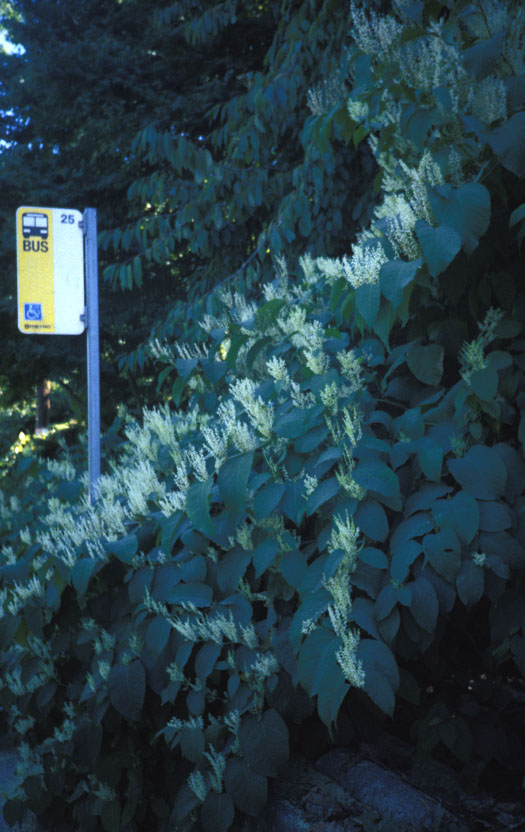
|
| Japanese Knotweed; Polygonum cuspidatum S. & Z. |
Buckwheat Family; POLYGONACEÆ
|
| Seattle has Japanese Knotweed, Giant Knotweed, and most common of all, the
hybrid between the two species. Long ago, Japanese Knotweed was introduced to North America as an ornamental or decorative foliage plant called Japanese Fleeceflower,
or (why?) Mexican Bamboo. It spread like mad in this country. We shall always have this tough, bold perennial, which can reseed,
as well as increase by rootstock. It is as persistent as any plant, mightily resisting manual eradication or doses of poison. It can
grow anywhere. |
| Some of its family kin include buckwheat, rhubarb, sorrels, docks, bistorts, water peppers, devil's shoestring, silver lace
vine, smartweed, and black bindweed. A mixed cast indeed. |
| The Greek-based generic name
Polygonum means "many-kneed," referring to the stems being "knotted" with conspicuous
knee-like joints. This Asiatic knotweed's stem is as segmented as any, but its more prominent feature is its
large size. During March and April the stems surge forth from woody roots, looking like plump asparagus shoots. Unlike feathery asparagus, Japanese Knotweed
is plump, robust, and bears broad, floppy leaves about the size of a hand. With such broad leaves it cannot be mistaken for a
bamboo, though its jointed stem is bamboo-like, albeit not nearly as strong. |
| By July and August the stems have reached anywhere from 4 to 8 feet in length, are gently leaning, and delicately scent the
air with profuse tiny creamy white flowers, beloved by bees. These fluffy flowers are well called fleeceflowers. |
| Giant Knotweed (Polygonum
sachalinense Fr. Schmidt) is identical but twice as large. Its stems can reach 18 feet in length:
a feat unmatched by any local weed except Giant Hogweed. Giant Knotweed leaves can measure 17 inches long and 10 inches
wide: larger than this page. Size aside, they are the same limp, soft green kind as borne by Japanese Knotweed. The flowers, too, are similar. Giant Knotweed is just bigger, and never or rarely reseeds, so is less common, growing only where its roots are deposited. (Turns out that most Seattle specimens are hybrids between Japanese and Giant Knotweed, though purebred Japanese and Giant do exist here also. The above photo shows the common hybrid.) |
Both species turn yellowish and drop their leaves in October, revealing hollow stalks that gradually darken, dry and persist
erect, making a clump of bare brittle stalks. Thus the name
Summer Bamboo sometimes applied. Next spring, the young shoots, about a
foot high, can be picked and eaten raw. They are very crunchy, dripping with juice, and sour. Cooked, they can become
sickeningly squishy and sweetish. Pies can be made. But
my attempt was edible, but not worth eating. If a more patient or innovative person
tried, certainly excellent dishes might be secured from these wild foods. The oxalic acid content, however, may be high enough that
you should consume only one serving a week.
|
Originally published as the Seattle Tilth newsletter Weed of the Month in March 1992, along with an illustration from a book.
Back |
|
|

